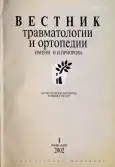Clinical and radiological parallels in congenital gigantism of the hand in children
- Authors: Shvedovchenko I.V.1, Bergaliev A.N.2, Sosnenko O.N.2
-
Affiliations:
- Scientific and Practical Center for Medical and Social Expertise, Prosthetics and Rehabilitation of the Disabled. G.A. Albrecht
- Research Children's Orthopedic Institute. G.I. Turnera
- Issue: Vol 9, No 1 (2002)
- Pages: 21-25
- Section: Articles
- URL: https://journals.rcsi.science/0869-8678/article/view/97083
- DOI: https://doi.org/10.17816/vto97083
- ID: 97083
Cite item
Full Text
Abstract
Analysis of clinical manifestations of congenital wrist gygantism was performed in 67 children. Working classification of that pathology that facilitated the choice of surgical tactics was suggested. The following examination methods were used: roentgenologic (39 patients), rheovasographic (33) and radionuclide (12). Scintigraphic data of blood circulation and osteogenisis was detected to conform the clinical forms of the disease. Neither roentgenography nor rheovasography showed that correlation. The advantages of radionuclide method are its relative simplicity, sufficient informativeness and trustworthiness, low radiation load as well as possibility to obtain the data concerning bone tissue, growth zones and blood circulation of damaged segment.
Full Text
##article.viewOnOriginalSite##About the authors
I. V. Shvedovchenko
Scientific and Practical Center for Medical and Social Expertise, Prosthetics and Rehabilitation of the Disabled. G.A. Albrecht
Author for correspondence.
Email: info@eco-vector.com
Russian Federation, Saint Petersburg
A. N. Bergaliev
Research Children's Orthopedic Institute. G.I. Turnera
Email: info@eco-vector.com
Russian Federation, Saint Petersburg
O. N. Sosnenko
Research Children's Orthopedic Institute. G.I. Turnera
Email: info@eco-vector.com
Russian Federation, Saint Petersburg
References
Supplementary files












